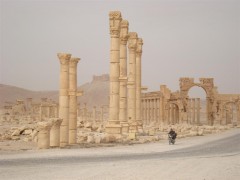You may remember a while back 501 Places featured an excellent guide to learning languages with a host of unorthodox but highly effective tips. James Willcox is back with a second post, this time on the subject of the famous Silk Road. He explores whether the route has managed to retain its sense of mystery and adventure despite the demise of the ancient trading routes and the advent of tourism. Well worth a read…
 The Silk Road. Perhaps the most evocative of all great overland travel journeys. Yet, in 2011, are these words anything more than a cheap travel marketing tool? I have taken guests to destinations all along “The Silk Road” and recently I was beginning to think that the name was sounding just a little cliched. Last week I packaged our winter Afghan ski and climbing trips as “A journey along the White Silk Road”.
The Silk Road. Perhaps the most evocative of all great overland travel journeys. Yet, in 2011, are these words anything more than a cheap travel marketing tool? I have taken guests to destinations all along “The Silk Road” and recently I was beginning to think that the name was sounding just a little cliched. Last week I packaged our winter Afghan ski and climbing trips as “A journey along the White Silk Road”.
It is a thousand years since major trade passed from East to West via Central Asia and 140 years since the German, Ferdinand von Richtofen, coined the phrase “Silk Road”.
I mean, who really uses the silk road today? It’s not a trading route any more. It’s long stopped being the path for goods travelling to the West from the East via the mountains and deserts of Central Asia. The famous route that saw not only silk but paper, tulips and even Rhubarb established in Europe. Sure Ughyer drivers ply the route between Osh and Kashgar and Chinese trucks fly down the Karakorum Highway; but spend a day at Rotterdam, Hong Kong or Singapore and you’ll realise that this trade is but a dribble. An afternoon spent at Port Said, Suez or by the Panama canal quickly cements how world trade is run and it ain’t through Central Asia.
So my question is: what is the silk route nowadays except a way for travel agents to romanticise the ruins of ex-soviet republics and the lands of Turko-Persia? Take an image of a wizened Uzbek man in embroidered skull cap, mix with some turquoise Timurid tiles and add a dash of Bactrian camel and you’ve got yourself a Silk Route tour brochure. I should know, I’ve made a few!!!
But don’t go away. This is not a cynical piece, honest.
 Whilst we were designing some “White Silk Road” trips I mentioned my jaundiced thoughts to a colleague and he said that I was talking rubbish. He told me that there is a group of people who do still ply the whole length of the silk route. From the ruined Greco-Roman pillars of Palmyra to Terracotta Warriors of Xi’an and beyond. They travel further than any Sogdian trader, further than Xuan Zang, sometimes cover even greater distances than Marco Polo. Like their predecessors, they brave politically unstable regions, have to fight, bargain and pay for passage through nation states. They suffer hardships but receive great rewards. They are of course the very people who the lure of the Silk Road attracts; the independent traveller.
Whilst we were designing some “White Silk Road” trips I mentioned my jaundiced thoughts to a colleague and he said that I was talking rubbish. He told me that there is a group of people who do still ply the whole length of the silk route. From the ruined Greco-Roman pillars of Palmyra to Terracotta Warriors of Xi’an and beyond. They travel further than any Sogdian trader, further than Xuan Zang, sometimes cover even greater distances than Marco Polo. Like their predecessors, they brave politically unstable regions, have to fight, bargain and pay for passage through nation states. They suffer hardships but receive great rewards. They are of course the very people who the lure of the Silk Road attracts; the independent traveller.
You may think this analogy absurd but the more we discussed it, the more the parallel seemed to hold. Even today a trip from the Med to China takes some doing. Coming from Europe, Russia, the Caucasus or Iran are the easy bit. It is the heart of Central Asia that is the challenge. Do you run the gauntlet of Baluchistan, battle the paperwork of Turkmenistan or for the intrepid few face the awesome prospect of independent travel in Afghanistan?
The Bactrian Camel has given way to the train and bus but many bring their own transport, some four wheel, some two wheel. Occasionally people walk the route, ride horses or lead their donkeys. It is not trade and money that leads them this way but the search for experiences, challenges and adventures that are fast disappearing from much of the well worn routes of the rest of Asia.
 Like in the chaikhanas and caravanserais of the heyday of the Silk Road rumour is always rife in today’s guesthouses. Talk is of letters of introduction for Iran, visas on arrival in Sost, whether the Khyber Pass is open, how to get the elusive Turkmenistan transit visa and where to get a copy of the timetable for the ferry from Baku to Aqtau?
Like in the chaikhanas and caravanserais of the heyday of the Silk Road rumour is always rife in today’s guesthouses. Talk is of letters of introduction for Iran, visas on arrival in Sost, whether the Khyber Pass is open, how to get the elusive Turkmenistan transit visa and where to get a copy of the timetable for the ferry from Baku to Aqtau?
Travellers really do walk in, brushing off the dust of the road and before they get their lips around a cup of tea are being interrogated about the road, embassies and borders ahead.
In the past the great desert Khanates were the safe havens where weary travellers and traders could rest up and get news of the route ahead. Nowadays it is the traveller hotspots like The Regale in Lahore, The Rose in Peshawar, The Madina in Gilgit. The Chini Bagh in Kashgar and the Baihualin in Urumqi. The Silk Road in Yazd and the Nomads Home in Bishkek. The list goes on but not for too long. You see the joy of the new Silk Road is that there are not hoards of backpackers with identikit guest-houses in each town. These oases where you can escape from the rigours of the road and get news of the way ahead are the exception not the rule. They are places of refuge where people knock before coming in your room, where your passport is not checked three times a day by a myriad of police and where sheets are changed if not daily then at on some sort of schedule.
The Silk Road really is no more and although you’ll find a Jipek Jolu in Bishkek and a Rah e Abrisham* in Yazd they are not The Silk Road. That way of life died a long, long time ago but the mountains, deserts and rivers are still there. The challenge still exists and in a back corner of Osh or Kokhand or Balkh you might just catch a glimpse of it.
*Turkic and Persian for Silk Road.
 James Willcox is MD of Untamed Borders a company who specialise in some of the wild parts of the Silk Road. When not running Untamed Borders he is a big promoter of Independent travel and quite cynical about the tourism industry.
James Willcox is MD of Untamed Borders a company who specialise in some of the wild parts of the Silk Road. When not running Untamed Borders he is a big promoter of Independent travel and quite cynical about the tourism industry.





I have to say that the Silk Road is still an awesome adventure. I just read Colin Thubron’s “Shadow of the Silk Road” and was very impressed. I think one of the main draws of the Silk Road is that, even today, it remains relatively wild and inhospitable. Throw in that a lot of it crosses areas that are still deemed dangerous, and you do have a true modern adventure.
While I agree that it’s not THE Silk Road, the idea and draw of it remains strong. And it’s still no small feat to travel the entire traces of the storied route.
I used to think the days of traders travelling the silk route were long gone and it was only travellers who made these type of journeys but i was wrong.
Two days ago i crossed overland between India and Pakistan. The border was quiet except for me and a lady from Turkmenistan. She couldn’t speak English, Hindi or Urdu and my Russian and Turkic are pretty awful so we settled on Farsi as a lingua franca. She asked me to fill out her customs and immigration forms and with her porters in tow we crossed the one kilometer of no-mans land between the border posts. It turns out that twice a year she flies from Ashgabat to Kathmandu and returns overland via India, Pakistan and Iran buying and selling goods on the way. She and i it turned out were well known to the chai and taxi wallahs on the Pakistan side of the border and we shared a ride to Lahore where we said our goodbyes.
I might add at this point that she is 62 years old. She just enlisted the help of porters of people like me to help her with no fuss and no bothere even though she couldn’t speak a word of Urdu, Punjabi or English.
Hats off to her… a true reminder of the spirit of the silk road.
Brilliant story James
The Lure of the Silk Route …. the intrigue, the curiosity, the fascination …. your article and images are a start to my research on the Silk Route, a trip I plan to chart next year. Amazing read!